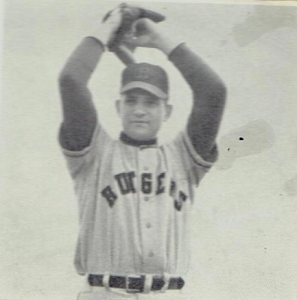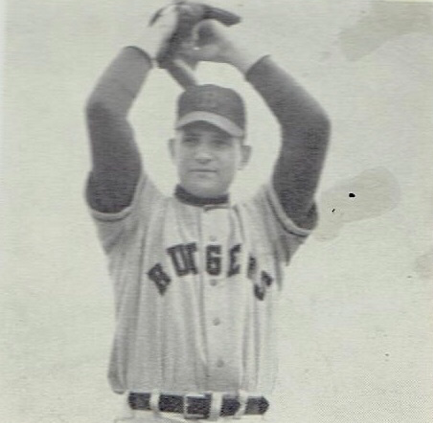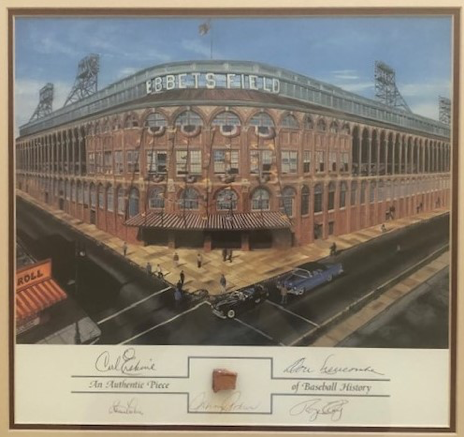April 10, 1958: Rutgers edges St. John’s on Paul Tootleman’s three-hitter at empty Ebbets Field
“Ebbets Field just isn’t the same.” – Roscoe McGowen1
Brooklyn’s Ebbets Field was a special place for baseball fans of all ages. Baseball’s literature tells the story of the National League’s Brooklyn Superbas, Robins, and Dodgers – over 3,400 games in 45 seasons (1913-1957) and 28 World Series games in nine different postseasons.2
Ask any kid about a very first visit to the storied ballpark at Bedford Avenue and Sullivan Place.3 What might they remember? The sparkling white home uniforms with a favorite number on the back. Pee Wee, Duke, Skoonj, Gil, Oisk, Campy, Jackie, and all the rest. The luscious green grass of the playing field meticulously framed by lines of white chalk. It was a sight one could only imagine watching Dodgers games on a small black-and-white television.
Ebbets Field hosted its last Dodgers game on September 24, 1957.4 Nearly seven months later, in April 1958, with Opening Day only five days away, the Los Angeles Dodgers and the San Francisco Giants were getting ready to open the season on the other side of the continent at Seals Stadium in San Francisco.5 Still, the playing field in Flatbush was ready for a baseball game.
SABR author Rory Costello recounted how Ebbets Field clung to life after that last Dodgers game until the wrecking ball struck on February 23, 1960.6 The ballpark entertained with soccer, the circus, and even the demolition derby. Soccer matches were very popular, often drawing crowds in excess of 20,000.7
College baseball also became part of the entertainment fare in 1958 and 1959 when St. John’s University and Long Island University hosted a slate of home games. Costello notes that Buck Lai, LIU coach, Dodgers scout, and instructor at Dodgertown Camp for Boys, was instrumental in bringing college baseball to Ebbets Field.8
Brooklyn baseball fans were still mourning the loss of Dem Bums,9 and the sparse crowd for Ebbets Field’s Opening Day 1958, St. John’s (2-3) vs. Rutgers (2-3), reflected that sentiment. A photo of an empty Ebbets Field on the first page of the New York Times sports section provided the evidence.10 Sportswriter Roscoe McGowen suggested that the major-league scouts in attendance, there to watch no particular prospect, outnumbered the fans.
Both teams had notable leaders. St. John’s Jack Kaiser, a Brooklyn native, was well on his way to a legendary 18-year coaching career (1956-1973) with the Redmen11 – two seasons, a combined 37-9 record, and two NCAA tournament appearances. He played for St. John’s in the 1949 College World Series and four seasons in the Boston Red Sox minor-league system (1950-1953).
Rutgers’ George Case, a former major-league outfielder with the Washington Senators and Cleveland Indians and a four-time American League All-Star, was now in his ninth season as the Scarlet coach. He was still seeking to match the success of that very first season – a trip to the 1950 College World Series.12 The Rutgers Targum noted that Case had been complaining about the distant fences on Rutgers’ University Heights home field.13 He was going to like the bandbox dimensions of Ebbets Field.14
 The respective coaches picked Charles Schmidt to start for St. John’s and lefty Paul Tootleman (1-0) to take the mound for Rutgers.
The respective coaches picked Charles Schmidt to start for St. John’s and lefty Paul Tootleman (1-0) to take the mound for Rutgers.
The Redmen took the early lead with their first two batters of the game. Tootleman walked Vinnie Merola, who scored on Hugh Kirwan’s triple up the right-center-field alley. It was the only earned run that Tootleman would yield all day.15 Tootleman stranded Kirwan by striking out Ted Schreiber and Frank Ciraulo and inducing Chris Affrunti’s groundout to second.
Rutgers took back the lead at 2-1 in the second inning on singles by Bob Hoffer, Bill Hopwood, and George Carlson and a throwing error by Redman right fielder Dom Moreo. They added another run in the third inning when Jake Quick doubled to left-center and scored on Hoffer’s line single to left, his second hit of the game. Rutgers 3, St. John’s 1.
Rutgers added another run in the fourth inning. Hopwood, who had singled, stood on third with two outs and Tootleman at the plate. When second baseman Schreiber could not handle Tootleman’s groundball, Hopwood scored with what proved to be the deciding run even though the game was far from over.
The score stood at 4-1 until St. John’s batted in the seventh. Tootleman could only blame himself for what was about to happen. He walked one batter and hit another one, sandwiching a pair of strikeouts in between. When Affrunti tapped back to Tootleman, the pitcher threw wildly past first baseman Lee Ammerman and two runs scored, but Affrunti was thrown out at third trying to advance and ending the inning.16 The Redmen still trailed, 4-3.
Relievers Jack Prendergast and Ed Brennan retired the Rutgers side in order over the last three innings, so it was Tootleman’s determination and endurance that sealed the victory for the Scarlet despite yielding five walks, three hit batsmen, and one wild pitch. Tootleman limited St. John’s to three hits in the complete-game performance and struck out 10 batters, pushing his two-game season total to 23 strikeouts.17 He was on his way to the third best single-season ERA (1.56) in Rutgers baseball history.18
Although this was only the seventh time the two teams had played baseball against each other, the Scarlet victory over St. John’s was their first since 1884.19 It was actually the Rutgers football team that had Ebbets Field in its history. Their 14-0 win over Newport Naval Reserves in 1917 marked the first college football game ever played at this storied ballpark.20
St. John’s had the great fortune to be the home team again at Ebbets Field in 1958, beating Manhattan College and Hofstra College, but losing to New York University. In 1959 they split two games with Manhattan.21 St. John’s finished its 1958 season with a 14-10 record, while Rutgers’ season record stood at 8-9.
What was it like to play at Ebbets Field as a college baseball player? Schreiber remembered well. “The field was so smooth! The regular places I played in Brooklyn, the Parade Grounds was good, but get in front of a ball in Marine Park, you deserve combat pay. I was impressed. As soon as you come out of the tunnel, you see the lights and it takes hold. It was very exciting to be on a major-league field.”22
Schreiber was one of the 11 third basemen for the hapless 1963 New York Mets, his only season in the majors. He never hit a home run for the Mets, but he did hit one at Ebbets Field when St. John’s beat Manhattan College, two weeks after the Redmen lost to Rutgers.23 Schreiber recalled, “Most of my career, I never saw the ball hit the bat. But a lefty was pitching, so the angle was good, and the ball was out in front of the plate. My concentration was so keen, I didn’t look up, I was running hard to first base. Then I heard a rattle, and I knew it had to be the ball in the seats.”24 That’s what a home run did at Ebbets Field after the Dodgers left Brooklyn!
What about the winning pitcher, Paul Tootleman? Tootleman finished his Rutgers career in 1959 having earned his letter for three seasons. Tootleman was recruited by the Detroit Tigers but never played professional baseball.25 Instead, his considerable baseball skills led him to a long career as a power-hitting first baseman in a Rockland County (New York) softball league.
In 1983, White Plains (New York) Journal News sportswriter Bill Madden’s column quoted a local softball veteran who tabbed Tootleman as one of the three best softball players to ever play in Rockland County.26 Others agreed with the sentiment. In 1985 Tootleman was inducted into the Rockland County Softball Hall of Fame.27 He earned that honor just as he earned that win from the hallowed mound of an empty Ebbets Field.
Author’s note
This game intrigued the author, a Brooklyn Dodgers fan as a kid in the 1950s, who fondly remembers visiting his grandparents’ home in Jamaica, Queens, a stone’s throw from the new St. John’s campus and the future site of Jack Kaiser Stadium. The author, a Rutgers graduate in the Class of 1966, broadcast baseball and basketball play-by-play on WRSU, the campus radio station, during his undergraduate days.
Acknowledgments
A thank-you to SABR author Rory Costello for inspiration about a time in Brooklyn that fans of a certain age wish had never happened. Another thank-you to Paul Tootleman’s son, Sandy, for his enthusiasm and insights in contributing to the research effort for this Games Project essay. This essay was fact-checked by Kurt Blumenau and copy-edited by Len Levin.
Sources
The author accessed the following college baseball references: Rutgers Baseball Fact Book; Baseball Reference; St. John’s Baseball 2023 Record Book. The digitized Rutgers University Libraries’ collection of the Rutgers Targum was used for insights on the 1958 baseball season.
The Ebbets Field lithograph is owned by the author and contains an authenticated piece of brick from the old ballpark as well as the autographs of Carl Erskine, Clem Labine, Johnny Podres, Don Newcombe, and Roger Craig. The photo of Paul Tootleman was provided by the Tootleman family.
Notes
1 Roscoe McGowen, “Ebbets Field Just Isn’t the Same,” New York Times, April 11, 1958: 28.
2 Bob McGee, The Greatest Ballpark Ever (New Brunswick: Rutgers University Press, 2005). Gregory H. Wolf, ed., Ebbets Field – Great, Historic, and Memorable Games in Brooklyn’s Lost Ballpark (Phoenix: Society for American Baseball Research, 2023).
3 Steven C. Weiner, “June 3, 1951: Don Newcombe strikes out 12 Cubs in Sunday opener at Ebbets Field,” SABR Baseball Games Project. Steven C. Weiner, “June 3, 1951: Preacher Roe, Gene Hermanski lead Dodgers to sweep of Cubs,” SABR Baseball Games Project.
4 Rory Costello, “Major-League Finale at Ebbets Field,” in Gregory H. Wolf, ed., Ebbets Field – Great, Historic, and Memorable Games in Brooklyn’s Lost Ballpark, 384.
5 Kevin Larkin, “April 15, 1958: Giants, Dodgers meet on the West Coast for the first time,” SABR Baseball Games Project.
6 Rory Costello, “Twilight at Ebbets Field,” The National Pastime (Volume 26, 2006).
7 Costello, “Twilight at Ebbets Field.”
8 Costello, “Twilight at Ebbets Field.” Lai was a career minor-league and semipro third baseman. Under contract with the New York Giants to start the 1928 season, he remained on the roster for a month, but never appeared in a game, earning the designation as a phantom major leaguer. See Paul Dickson, The Dickson Baseball Dictionary, 3rd Edition (New York: W.W. Norton & Company, 2009), 632.
9 “Traditional affectionate nickname for the Brooklyn Dodgers established and characterized by a bewhiskered cigar-chomping cartoon tramp drawn by Willard Mullin (New York World-Telegram, August 9, 1939).” Dickson, 250.
10 McGowen.
11 St. John’s changed its nickname to Red Storm in 1994. (“Call St. John’s the Red Storm,” New York Times, June 9, 1994: B18.)
12 Steven C. Weiner, “June 15, 1950: Rutgers’ late rally defeats defending champion Texas in College World Series opener,” SABR Baseball Games Project.
13 Steve Shoenholz, “Scarlet Nine Bows to Tigers; Meets St. John’s Squad Today,” Rutgers Targum (New Brunswick, New Jersey), April 10, 1958: 3.
14 “A ballpark whose small dimensions make it easier to hit home runs, e.g., Baker Bowl in Philadelphia in the early 1930s and Ebbets Field in Brooklyn in the 1950s.” Dickson, 54. Selected dimensions for Ebbets Field in 1957: LF pole, 348’; CF, 393’; RF, 297’ (baseball-almanac.com/stadium/stadiume.shtml).
15 “Rutgers Nine Edges St. John’s, 4-3,” The Daily Home News (New Brunswick, New Jersey), April 11, 1958: 15.
16 “Rutgers Nine Edges St. John’s, 4-3.”
17 Shoenholz. Tootleman struck out 13 in his victory over CCNY nine days earlier. His second win surpassed his 1957 pitching record (1-4).
18 Through the 2023 season, Tootleman’s 1.56 ERA in 1958 ranked eighth in the Rutgers single-season record book. Rob Kenney holds the record with a 0.69 ERA in 1967.
19 Shoenholz.
20 “Rutgers Football at MLB Venues,” Rutgers Football Media Guide Archives. The long history of Rutgers playing football in major-league ballparks began in 1914 when the team lost to Washington & Lee (20-13) at the Polo Grounds.
21 Costello, “Twilight at Ebbets Field.”
22 Rory Costello, “Ted Schreiber,” SABR Baseball Biography Project.
23 “Schreiber’s Two-Run Circuit Drive Enables St. John’s to Beat Manhattan,” New York Times, April 25, 1958: 38.
24 Costello, “Ted Schreiber.”
25 Sandy Tootleman, email to author, August 7, 2023.
26 Bill Madden, “Area Players Have Lists of Their Own,” White Plains Journal News, September 3, 1983: 25.
27 Bill Madden, “Softball Hall of Fame to Induct New Members,” White Plains Journal News, March 27, 1985: 21.
Additional Stats
Rutgers Scarlet 4
St. John’s Redmen 3
Ebbets Field
Brooklyn, NY
Corrections? Additions?
If you can help us improve this game story, contact us.



